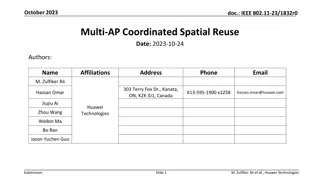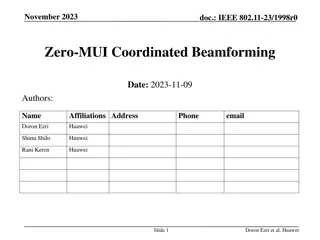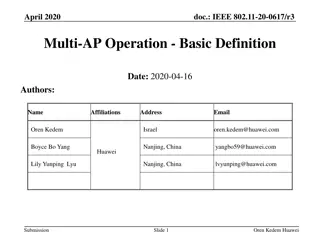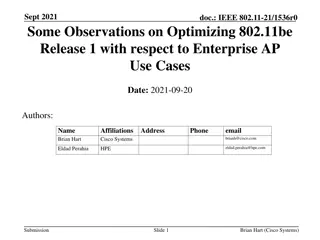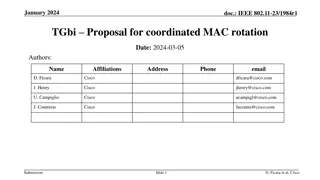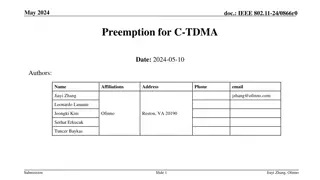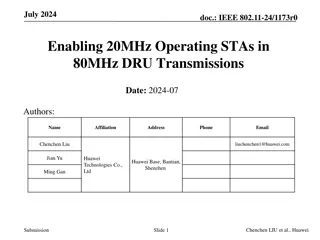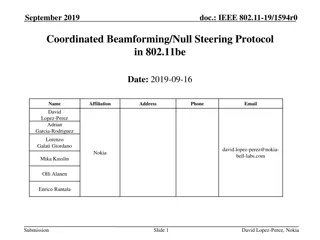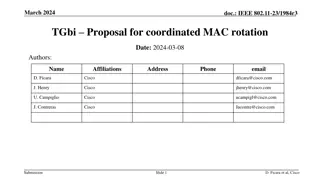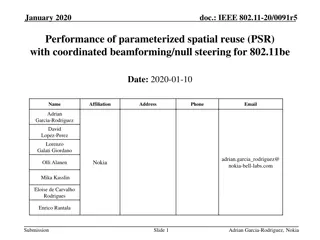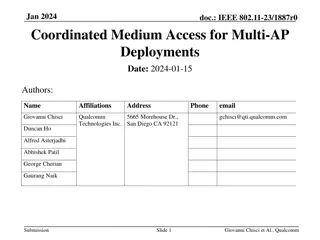Gain Analysis for Coordinated AP Transmissions in IEEE Enterprise R3 Network
This document discusses gain analysis results for coordinated AP transmissions in the IEEE Enterprise R3 network, focusing on tail latency gain for aperiodic traffic. Simulation setups, topology details, and results for different coordination schemes (C-TDMA, C-RTWT, and combined) are provided, showing latency improvements across the board.
Download Presentation

Please find below an Image/Link to download the presentation.
The content on the website is provided AS IS for your information and personal use only. It may not be sold, licensed, or shared on other websites without obtaining consent from the author.If you encounter any issues during the download, it is possible that the publisher has removed the file from their server.
You are allowed to download the files provided on this website for personal or commercial use, subject to the condition that they are used lawfully. All files are the property of their respective owners.
The content on the website is provided AS IS for your information and personal use only. It may not be sold, licensed, or shared on other websites without obtaining consent from the author.
E N D
Presentation Transcript
November 2023 doc.: IEEE 802.11-23/1962r0 Gain analysis for coordinated AP transmissions Date: 2023-11-02 Authors: Name Abhishek Patil Affiliations Address Phone email George Cherian Gaurang Naik Duncan Ho Qualcomm Alfred Asterjadhi Sanket Kalamkar Giovanni Chisci Sherief Helwa Submission Slide 1 Abhishek Patil, Qualcomm Inc
November 2023 doc.: IEEE 802.11-23/1962r0 Objective Background Previous contributions in TGbe provides gain analysis for C-TDMA with full buffer traffic (see 11-19/1879) Objectives of this contribution Provide gain analysis for coordinated AP transmissions with focus on tail latency gain for aperiodic traffic in IEEE Enterprise R3 network. Submission Slide 2 Abhishek Patil, Qualcomm Inc
November 2023 doc.: IEEE 802.11-23/1962r0 Topology: IEEE Enterprise R3 (reduced) 20 m 20 m BSS9-12 BSS13-16 BSS25-28 BSS29-32 BSS1-4 BSS5-8 BSS17-20 BSS21-24 40 4 6 S2 S1 S1 S2 30 5 S1 IEEE Ent R3 topology reduced to 40x40m square [m] S2 20 2 S2 S1 10 1 3 S1 S1 S2 S2 0 10 20 [m] 40 30 Submission Slide 3 Abhishek Patil, Qualcomm Inc
November 2023 doc.: IEEE 802.11-23/1962r0 Simulation setup 6 AP s (BSS1 to 6) each having 2 STAs. Config per BSS: LL DL for 1 STA (Poisson arrival) Short (1500 bytes) LL packets w/ mean arrival of ~0.7ms UL full buffer from the other STA C-TDMA scheduling scheme: TXOP owner shares TXOP with nearest AP(s) that have pending LL traffic Buffer checked at start of TXOP and shared TXOP duration is based on the buffer size TXOP can be shared with up to 2 other APs C-RTWT scheduling scheme: SPs are assigned in round-robin fashion among the 6 APs 12 ms split into six 2 ms SPs. C-RTWT + C-TDMA scheduling scheme: SP owner (equivalent to TXOP owner) can share TXOP with other APs TXOP sharing scheme same as the C-TDMA schedule scheme 12 ms split into six 2 ms SPs. Sim drops/duration: 10 drops for 20sec each Max TXOP = 4ms Submission Slide 4 Abhishek Patil, Qualcomm Inc
November 2023 doc.: IEEE 802.11-23/1962r0 Simulation results Total latency (usec) Mean Median P95 Baseline 16283 9268 56478 CTDMA 8917 6436 25286 CRTWT 4862 3457 12638 CTDMA + CRTWT 2306 1639 6558 COORDINATED AP TX GAINS CTDMA CRTWT CTDMA + CRTWT 10.00 8.61 9.00 7.06 8.00 7.00 5.65 6.00 GAIN (X) 4.47 5.00 3.35 4.00 2.68 2.23 1.83 3.00 1.44 2.00 1.00 0.00 MEAN MEDIAN P95 Total latency indicates the e2e 1-way latency and accounts for channel access and queuing delays. Submission Slide 5 Abhishek Patil, Qualcomm Inc
November 2023 doc.: IEEE 802.11-23/1962r0 Summary The contribution provides simulation results for IEEE enterprise R3 topology for C-TDMA, C-RTWT and the combined scheme. The results show gains for all 3 coordination schemes with higher gains when both schemes are applied together. Submission Slide 6 Abhishek Patil, Qualcomm Inc


